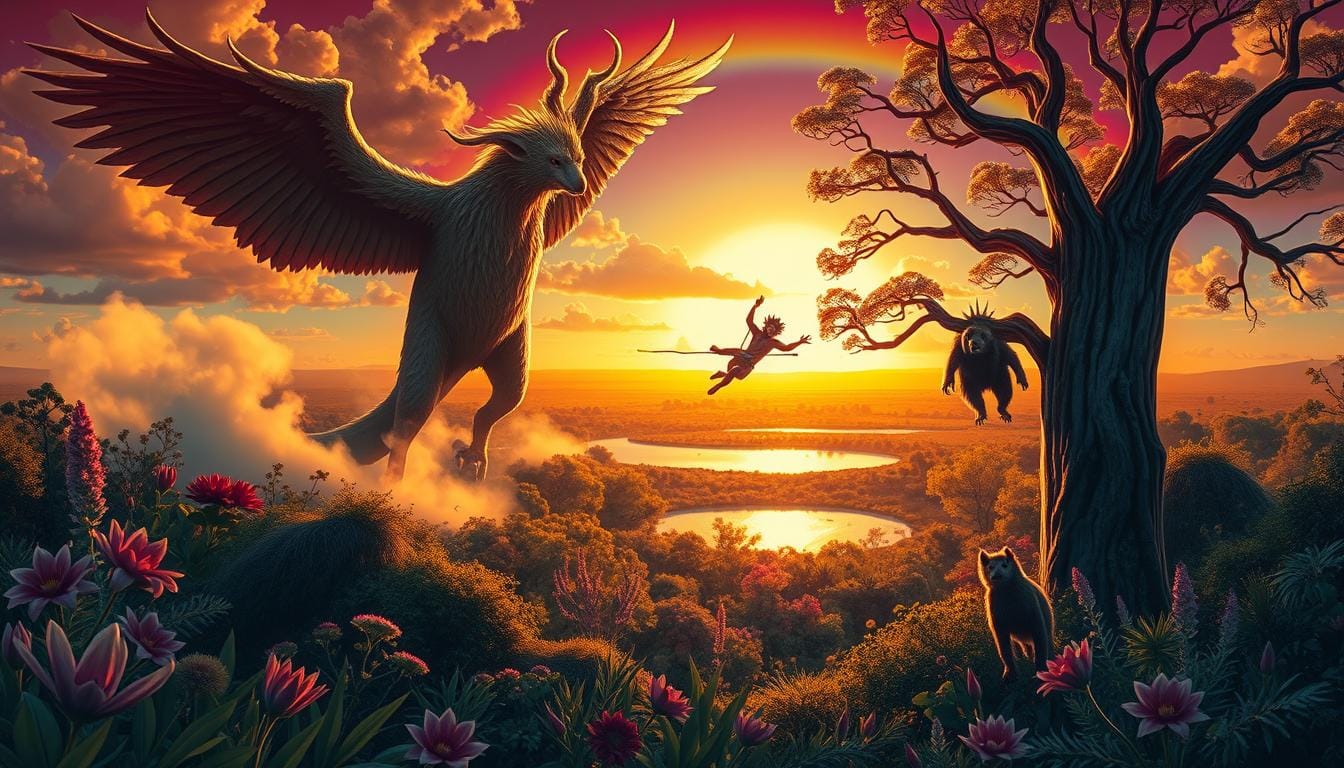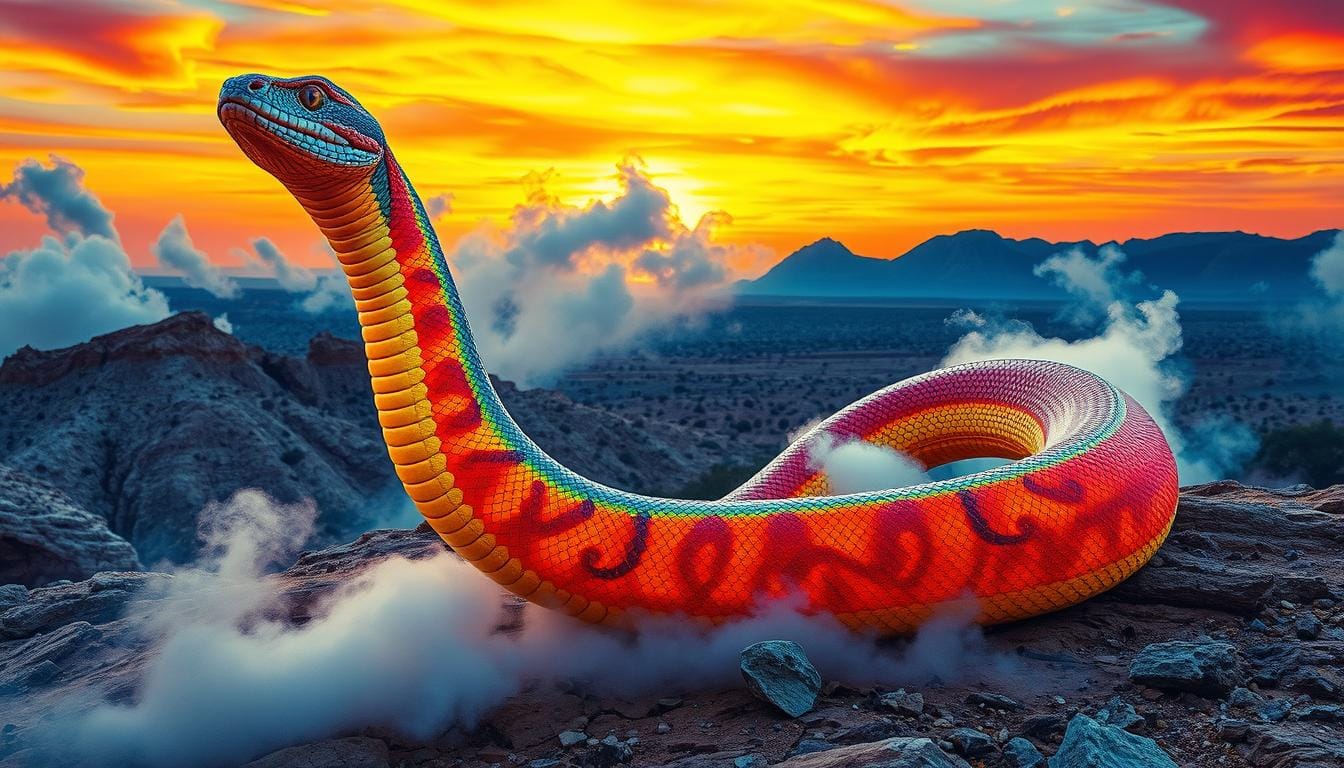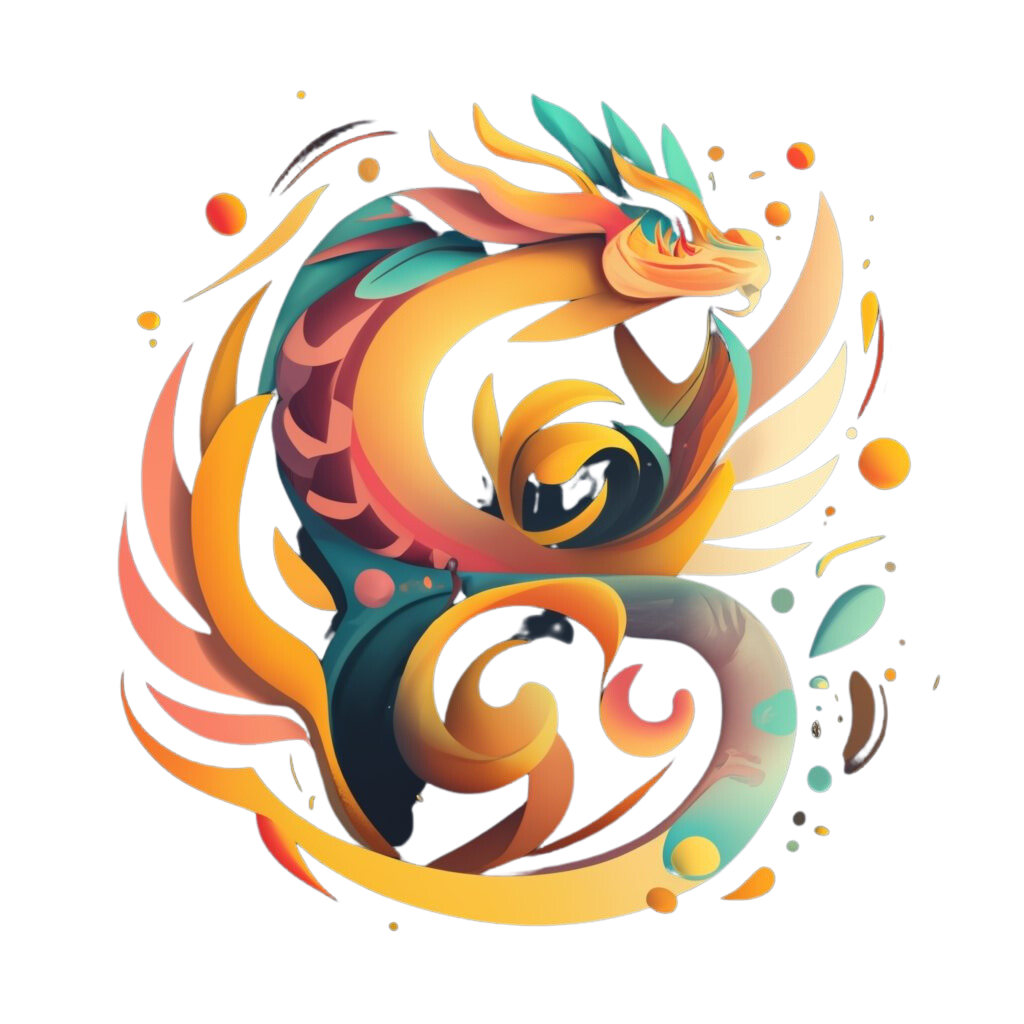Explore the magical world of Australian mythical creatures. They are deeply connected to aboriginal mythology and australian myths and folklore. These creatures have shaped the Outback and its people.
Learn about the stories of Australian mythical creatures. These tales have been shared for many years. They are a big part of australian myths and folklore. Australia's rich culture is seen in its many mythical creatures.
Ready to dive into the world of Australian mythical creatures? Here, reality and myth mix, and stories come to life.

The Rich Heritage of Australian Mythology
Australian mythology comes from the Aboriginal people's history and culture. It spans thousands of years. The Dreamtime is a key part of Aboriginal mythology, filled with stories, songs, and dances passed down through generations.
The Dreamtime is very important in Aboriginal culture. It's when the world was made and nature's laws were set. It's also when ancestors roamed the earth, making the landscape, animals, and people. This idea is key to understanding Australian mythology and its lasting impact on Aboriginal stories, art, and traditions.
Origins of Australian Folklore
Australian folklore comes from Aboriginal stories and legends. These stories were shared through oral traditions. Each generation added their own twist, making a rich and diverse collection of tales.

The Role of the Dreamtime
The Dreamtime is vital in Australian mythology. It helps us understand the world and nature's laws. It's when ancestors taught people about the environment, animals, and each other.
It's also a time when people could talk to ancestors for guidance and wisdom.
How Oral Traditions Shaped Australian Myths
Oral traditions have shaped Australian myths and legends. Stories, songs, and dances passed down through generations have kept Aboriginal history and culture alive. These traditions have also influenced broader Australian mythology, with many stories shared and adapted by different cultures and communities.
Australian Mythical Creatures in Aboriginal Culture
Australian myths and folklore are full of mythical creatures. These creatures are linked to the land, animals, and nature. They are key to Aboriginal spiritual beliefs and traditions.
Stories about these creatures have been passed down for many generations. They are a big part of Aboriginal folklore.
Some famous creatures include the Rainbow Serpent, the Bunyip, and the Yowie. The Rainbow Serpent is seen as a powerful being. It's linked to the world's creation and the laws of the Aboriginal people.
The Bunyip is a mysterious creature found in swamps and rivers. It's both feared and respected by the Aboriginal people.
Polynesian mythical creatures also have an impact on Australian myths. For example, the Rainbow Serpent stories share similarities with the Maori's Taniwha. The Taniwha is a sea serpent that created the oceans and land.
- Association with the land and natural phenomena
- Deeply rooted in Aboriginal spiritual beliefs and traditions
- Influence from polynesian mythical creatures
- Play significant roles in Aboriginal folklore and storytelling
Australian mythical creatures are a big part of Aboriginal culture. They are important in the country's folklore. By learning about these creatures, we can understand Aboriginal spiritual beliefs better. We also get to appreciate Australia's unique cultural heritage.
The Rainbow Serpent: Australia's Most Sacred Being

The Rainbow Serpent is very important in aboriginal mythology. It plays a big role in australian myths and folklore. This sacred being is a big part of Australia's culture. Its story and meaning change in different places.
The Rainbow Serpent is linked to the world's creation and the natural order. It's not just in creation stories. It also shows the balance of nature and the environment.
Origin Stories of the Rainbow Serpent
There are many stories about the Rainbow Serpent. Each story is special and has its own meaning. Some say it made rivers, lakes, and waterholes. Others see it as a symbol of fertility and plenty.
Cultural Significance Across Regions
The Rainbow Serpent means different things in different places in Australia. This shows how diverse aboriginal mythology and australian myths and folklore are. In some places, it's seen as a kind being. In others, it's feared and respected for its power.
- In some Aboriginal cultures, the Rainbow Serpent is linked to the world's creation and the natural order.
- In other cultures, the serpent is connected to nature's cycles and the environment's balance.
- The Rainbow Serpent is also a key symbol in australian myths and folklore. It shows the link between the physical and spiritual worlds.
The Rainbow Serpent is a key figure in aboriginal mythology and australian myths and folklore. It keeps inspiring and teaching people about Australia's rich cultural heritage.
Fearsome Creatures of the Bush
The Australian bush is full of fascinating and sometimes scary creatures. Some are found only in Australia, while others are known in New Zealand and Polynesian islands. Learning about these creatures helps us understand the fears and respect they inspire across the Pacific.
In Australian folklore, the Bunyip is a big creature that lives in swamps and rivers. The Yowie is a mysterious ape-like being said to live in the forests. New Zealand has the Taniwha, a powerful serpent-like creature. The Niuhi-Shark in Polynesian mythology can shape-shift and control the oceans.
These creatures are more than just stories. They are a big part of their countries' cultures. By studying these creatures, we learn more about the values and beliefs of their creators. Looking at Australian, New Zealand, and Polynesian creatures shows us how each culture is unique.

In conclusion, the fearsome creatures of the Australian bush are key to its folklore and culture. By comparing these creatures with their New Zealand and Polynesian counterparts, we appreciate the Pacific region's cultural diversity. Mythology helps us understand our world in a deeper way.
Water Spirits and Ocean Guardians
Australian continent mythology is full of stories about water spirits and ocean guardians. They play a big role in australian myths and folklore. These beings are linked to the country's vast coastline, rivers, and lakes. They are believed to have supernatural powers.
Water spirits live in the ocean, rivers, and lakes. They are seen as mysterious and powerful. The Bunyip, for example, lives in Australia's rivers and lakes. It is feared for its fierceness.
The Bunyip's Domain
The Bunyip is a fascinating creature in australian continent mythology. It lives in Australia's rivers and lakes. It is said to be a large, serpent-like creature with a long neck and flippers. It can swim very fast.
Coastal Legends
Coastal legends are a big part of australian myths and folklore. They often feature water spirits and ocean guardians. These stories are passed down through generations. They are believed to have spiritual significance.
Some famous coastal legends include the Mermaids and the Sea Serpents. These stories are well-known in australian continent mythology.
River Dwelling Entities
River dwelling entities are important in australian myths and folklore. They are linked to the country's rivers and lakes. These entities are believed to have supernatural powers.
In australian continent mythology, they are thought to be guardians of the water. They are respected for their wisdom and power.
Desert Dwellers and Outback Legends
In Australia's deserts and Outback, many mythical creatures roam. They are deeply rooted in aboriginal mythology. These stories have been passed down for generations.
They play a big role in the cultural and spiritual heritage of the indigenous people. The tales of these desert dwellers are fascinating. They give us a peek into the rich history and traditions of the Aboriginal people.
Some famous creatures include the Wanambi, a huge snake said to live in the deserts. There's also the Julunggul, a serpent-like creature linked to rainbows and fertility. These creatures remind us of the Taniwha, a legendary sea serpent from Maori mythology.
Even though they share similarities, each has its own special traits and stories. This shows the diversity and complexity of the cultures that created them.
Here are some key characteristics of desert dwellers and Outback legends:
- Deeply rooted in aboriginal mythology and culture
- Often associated with natural phenomena, such as rainbows and fertility
- Comparable to polynesian mythical creatures, such as the Taniwha
- Unique characteristics and stories reflecting the diversity of Aboriginal cultures
Exploring the stories of these desert dwellers helps us understand Aboriginal history and traditions. It also shows the importance of aboriginal mythology and polynesian mythical creatures today.
The Connection Between Australian Mythical Creatures and Natural Phenomena
Australian myths and folklore are closely tied to the country's natural wonders. The australian continent mythology is full of stories about creatures linked to the land, sea, and sky. These beings are often seen as connected to natural events and formations.
In australian myths and folklore, weather-related beings are very important. For example, the Rainbow Serpent is linked to rain and fertility. The Bunyip is said to live in swamps and rivers, and is sometimes connected to flooding and water events.
Weather-Related Beings
- The Rainbow Serpent: associated with rain and fertility
- The Bunyip: linked to flooding and water-related events
- Other weather-related beings: connected to storms, droughts, and other natural disasters
Landscape Formation Stories
Australian mythical creatures are also tied to the land's formation. For example, Dreamtime stories tell of how ancestors created the land. They traveled across the country, making mountains, rivers, and other natural features.
These stories are key to australian continent mythology. They help us understand the land and our place in it. By learning these stories, we can appreciate the natural world more.
Modern Sightings and Contemporary Tales
Australian mythical creatures are as exciting today as they were long ago. Social media makes it easy for people to share their stories. They talk about the bunyip and the rainbow serpent, keeping the myths alive.
Australian creatures are special compared to those in New Zealand. Polynesian creatures also have their own unique traits. Learning about these helps us understand the cultures and histories behind their stories.
Some interesting modern sightings include:
- Reports of the yowie, a large, hairy creature said to roam the outback
- Sightings of the bunyip, a mysterious aquatic creature said to inhabit swamps and rivers
- Encounters with the rainbow serpent, a majestic being said to have the power to control the weather
These stories show how much people love Australian mythical creatures. They also remind us of the importance of our cultural heritage. By sharing these tales, we keep the myths alive and inspire others to learn about our rich history.
Preserving the Legacy of Australia's Legendary Beings
As we finish our look at Australian myths and folklore, it's clear we must save these stories. They show the deep bond between the Australian people and their world. These tales are alive, telling us about the natural world and its magic.
In Australia, many groups are working hard to keep these stories alive. They hold storytelling events, cultural festivals, and create digital archives. This way, they help the next generation learn and share their heritage.
By celebrating Australian myths and folklore, we learn to value the Aboriginal people's unique spirit. Creatures like the Rainbow Serpent and the Bunyip teach us about nature and respecting the spiritual world.
FAQ
What are some of the most well-known Australian mythical creatures?
Famous creatures include the Bunyip, a scary water spirit. The Rainbow Serpent is a sacred being in Aboriginal myths. The Yowie, a hairy creature, is said to live in the bush.
What is the significance of the Dreamtime in Aboriginal mythology?
The Dreamtime is key in Aboriginal myths. It's when the world was made and laws were set. It's a place where ancestral spirits live and shape our world.
How have oral traditions influenced Australian myths and folklore?
Oral traditions have shaped Australian myths and folklore. Stories passed down through generations keep these myths alive. They change and grow over time.
What is the cultural significance of the Rainbow Serpent?
The Rainbow Serpent is very important in Aboriginal myths. It's seen as a creator god, making land, water, and animals. It stands for fertility, renewal, and life's cycle.
Are there any similarities between Australian mythical creatures and those found in other Polynesian mythologies?
Yes, there are similarities. For example, the Bunyip and New Zealand's Taniwha are both water spirits. These links show the Pacific region's shared culture and influences.
Are there any modern sightings or contemporary tales of Australian mythical creatures?
Yes, there are many reports of modern sightings. Some might be fake or wrong, but they show people are interested. These stories keep the legends alive.
What efforts are being made to preserve the legacy of Australian mythical creatures?
Efforts are being made to keep these creatures' stories alive. Aboriginal communities are documenting and sharing their myths. There are also educational materials and cultural events celebrating these legends.
